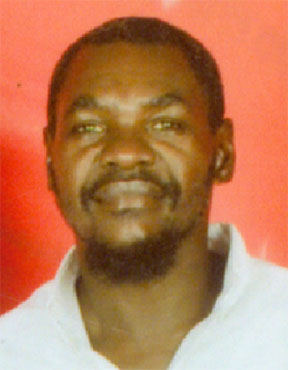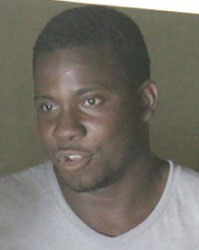After leading his defence yesterday in the death of fisherman Envil Pollard, whom he shot and killed on January 29th, 2015, murder accused ex-security guard Marlon Callender is likely to know his fate tomorrow when a jury is expected to deliberate on the case against him.
Leading his defence in unsworn testimony from the prisoner’s dock yesterday, the accused professed his innocence, while stating that he was only defending himself from Pollard, who had been advancing towards him with a knife.
The former security officer said he had asked the fisherman several times to remove from the prohibited fishing area of the Pritipaul Singh Investments wharf.

According to Callender, he also fired a warning shot, but his warnings were all ignored by Pollard, with whom security officers had had previous confrontations about fishing at the private wharf.
Callender’s story is that he became fearful for his life after Pollard advanced towards him with a “Rambo knife,” while cursing and threatening to kill him. It was at that point he said he shot him.
Relating what he claimed to be the events of the day in question, Callender said that he was performing armed duty when he was radioed by another security officer who told him that Pollard was refusing to leave the wharf though repeatedly spoken to.
The accused told the court that he then proceeded to the wharf area to “help the situation,” as was entailed by his job description as a security officer at Pritipaul Singh Investments.
He said he thereafter had a confrontation with Pollard, which resulted in him discharging a “warning shot” from the 12-gauge shotgun with which he was armed at the time.
According to him, at this point Pollard was in his fishing boat beneath the wharf in the river.
Callender said that several minutes after, Pollard then went onto the wharf, armed with the knife and was behaving disorderly, cursing and threatening to kill him.
“I became afraid for my life and I asked him again to leave the wharf,” the accused said.
He said that the man instead made a few steps towards him, at which point he fired a shot, which hit Pollard.
Noting that he had never before shot anyone, Callender stressed, “I was scared for my life when the deceased attacked me.”
While stating that he was sorry for the loss of life, the tearful accused said that he was only trying to protect himself and perform his duties.
Highly implausible
For her part, however, Prosecutor Lisa Cave said that the “trigger happy” Callender by his mere conduct was intent on killing Pollard or at least causing him grievous bodily harm.
In an impassioned closing address, she asked the jury to dispel Callender’s claim of self defence.
Cave said that at no time was the deceased ever on the wharf pursuing the accused. Instead, she said Pollard remained at all material times in his fishing boat, where he was gunned down by a “trigger happy” Callender.
The prosecutor asked the jury to also rubbish his claims that Pollard had been shot on the wharf and fell back into his boat, while noting that the pathologist did not find any injuries on the deceased other than the gunshots.
Referencing the doctor’s testimony, Cave said that one would have expected to see an injury of some sort on Pollard’s head, had he truly fallen off the wharf and back into his boat.
She noted, too, the evidence of police investigators, who said that nothing of evidential value was ever found on the wharf itself, but rather in Pollard’s boat, which bore several gunshot holes.
Pollard’s body was found in his boat.
Noting the dimensions of the wharf, Cave told the jury to reason the length of time it would have taken Pollard to pull himself up onto the wharf to get close enough to the accused, who she said could have sought assistance from other guards during that time.
Because of the distance Pollard would have been from Callender, the prosecutor surmised that the accused could not have been in any imminent danger as he wants the court to believe.
She opined that it was highly implausible that Pollard, having only a knife, would advance towards the accused who was armed with a gun.
Noting the popular saying, “you don’t carry a knife to a gunfight,” the prosecutor said Pollard would have known that he stood to lose the battle in such circumstances.
Further discrediting Callender’s story, Cave referenced the evidence of ballistic expert Sergeant Eon Jackson, who said that the spread-pattern of the pellets suggested that the deceased was shot at a distance.
This, she told the jury, was enough to dismiss Callender’s story of being attacked and/or placed in any imminent danger.
After examining the gun and the physical evidence of where the body had been found, Jackson had said that Pollard had to have been shot at a distance of over 20 feet away from where the shooter would have been standing.
Callender’s story, however, was that Pollard was close to him, which made him afraid for his life and he decided to shoot.
Cave, however, asked the jury to again recall the evidence of the pathologist, who said that no soot or gunshot residue had been found on the body.
Both Jackson and pathologist Dr. Nehaul Singh had said that such residue would only be left if the target had been shot at close range. The witnesses had said that the absence of such, however, indicated that the deceased was shot from some distance away.
Stressing that Callender did not have to shoot and kill, Cave opined that he was trigger happy and that is why Pollard lost his life. She argued that even if the accused felt that the situation warranted the use of gunfire, he could have aimed the weapon to the man’s lower limbs. She argued further that even if Pollard had been a nuisance, that was no reason for him to be shot and killed.
As a result, Cave urged the jury to find the accused guilty as charged for the capital indictment leveled against him.
No murderer
Meanwhile, saying that his client was no murderer and never left his home that morning with the intention of killing anyone, defence attorney Everton Singh-Lammy reminded the jury that the deceased had been shot with pellets.
In an equally passionate address, he asked jurors to bear in mind the peculiar nature and form of the spread-patterns, which are created when pellets are discharged from a gun.
It was against this backdrop that he surmised that even an aim to the lower limbs would cause the pellets to ricochet and spread in various directions.
Singh-Lammy contended that his client at all material times was only performing the duties mandated to him as a security officer.
He said that given the movement of millions of dollars on the premises on the day in question, the accused had to ensure not only the safety of the premises, but himself as well.
He rhetorically asked the jury what in the circumstances his client, who was being attacked by the knife-wielding Pollard, was supposed to do. He then posed the question again, rhetorically asking the jurors what they would have done in such a situation.
Referencing the testimony of several Pritipaul Singh employees that the wharf area was private and was bordered with no-trespassing signs, Singh-Lammy said that Pollard, though well aware of this, continued to nonetheless practice illegally fishing in the area.
Referencing the testimony of Desmond Sancho, however, of payments being made to security officers to facilitate fishing at the facility, Cave said that the no-trespassing rule could not be enforced sometimes.
She said that clearly a practice had developed and had been accepted by guards who would allow external fishers to cast their net in the so-called prohibited area. The rule, she said, needed to be consistent.
Singh-Lammy, however, maintained that the area was nonetheless private and knowing this, Pollard had no right to be there.
In all the circumstance he asked the jury to acquit his client and send him home.
The trial continues tomorrow morning at 9.30 at the Georgetown High Court, where Justice Sandil Kissoon will sum-up the case and hand it over to the jury for deliberations and the possible return of a verdict.










